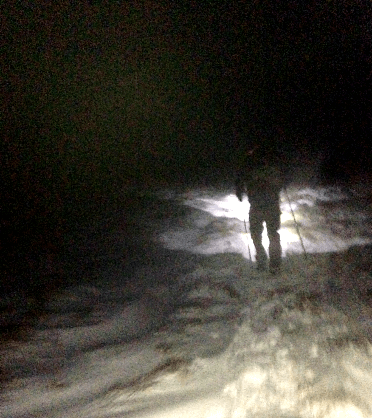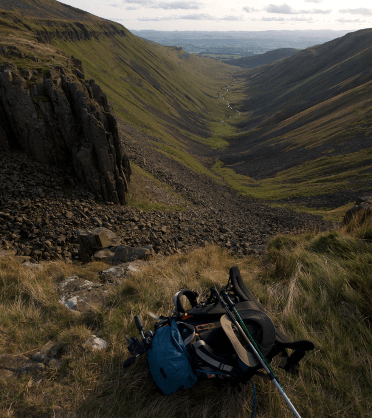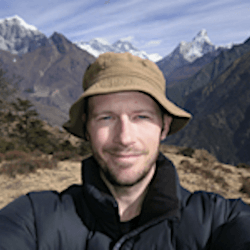Running the Spine Race
Damian Hall explains his love of the Spine Race, a mad midwinter run along England's oldest National Trail.
Running the Spine Race
https://contoursrun.co.uk/running-the-spine-race
by Damian Hall
Frozen water bottles, beach ball-sized blisters and entertainingly wild hallucinations: these are just a few staples from Spine Race mythology.
The Spine Race labels itself “Britain’s most brutal race”, and entrants must travel all 268 miles of the Pennine Way — the country’s oldest and most would agree toughest National Trail — within seven days.
In January.

When I first heard of the Spine Race, it planted a vice-like grip on my imagination.

I already had a great passion for the Pennine Way, having been incredibly fortunate in being asked to write a new official guidebook for it.
I love almost everything about the legendary yomp. I love how surprisingly wild and remote it feels, despite being right in the middle of northern England, in between big cities. I love how it introduces adorable little places — Dufton, Thwaite, Middleton-in-Teesdale — I had never heard of but didn’t want to leave.
The Pennine Way has always been a challenging trail, too, which thoroughly tests my navigation, equipment and sense of humour. But it constantly rewards with life-affirming moments, such as High Cup, Pen-y-ghent, Windy Gyle, Hardraw Force, Cross Fell, Hadrian’s Wall, the yellow Yorkshire Dales and copper Peak District.
I was purely a long-distance walker back when I first experienced the Pennine Way. I thought running was needlessly rushing: rushing through wilder places, not really connecting with the landscape, not stopping to listen to birds, admire wild flowers and clean cow pat off your boots.
I put this to a fell runner once (probably without the cow pat bit). After a pensive moment, he said, “But when you run, you cover more ground and you get to see so much more.” It was a simple and powerful argument and it freed me up ideologically.
When you run a trail or anywhere off-road you might not stop for every flower and insect, but you’re still hoovering it up into your mind and feeling great emotional attachment to the landscape. Running the Pennine Way, you might cover the same distance in one go that would take two or three days of walking, giving you an accelerated sense of the changing landscape and the country’s geography.


Imagine traversing the Yorkshire Dales all in one go, or covering the 41 miles from Middleton-in–Teesdale to Alston, two of the Pennine Way’s most dramatic and memorable walking days, in one. Which, come to think of it, is a bit greedy, but all the more memorable. And, of course, when you’re moving quickly, the dilemma of how and where to split the Cheviots into two days is no longer an issue.
After my longest efforts during the Spine Race, I admit that seeing my next destination could bring me close to the point of tears in relief. But, this tired and emotionally raw, a new scene or a fortunate wildlife encounter is felt all the more keenly. As you’re often out at times when a walker wouldn’t be, you’re more likely to see wildlife. Hordes of tiny shrews darting through the snow at 1am on Blenkinsop Common will stay with me for a long time.
It was thrilling to see the Pennine Way in a fresh way. Admittedly some of that fresh way was, well, in the dark. But few moments have equalled the one when I arrived at High Cup in 2014, alone, in the snow, at sunrise, high on endorphins from a night of running alongside the gurgling River Tees with its crashing waterfalls and across the bolshie North Pennine moors. The white floor dropped away before my feet to reveal an apocalyptic chasm. To my mind it’s the greatest view in England.


I couldn’t believe my luck when I arrived at High Cup in 2015 at the same time of day, again in the snow, but this time with some fine fellow runners to share it all with. The eventual race winner, Pavel Paloncý, shrieked with joy at the scene. A few minutes later, about 20 ponies galloped across our path.
It does all take a fair bit of effort, of course, and you can get so tired you experience for free the type of things people pay good money for: namely those hallucinations.
I always thought these would be sinister, but they were nothing of the sort. One of the great things about the Spine Race and long-distance challenges in general is the extraordinary kindness strangers show. I was given unsolicited food and drink many times, staff and volunteers were incredible kind and supportive, and I got an absurd amount of text messages, some from people I didn’t know had my number.
As a result, in 2014 I didn’t question it when strangers lit some large red Chinese lanterns for me in the Cheviots at 5am, to guide me into the finish at Kirk Yetholm. It seemed especially kind as I hadn’t slept for 30-odd hours. Turned out the lanterns didn’t exist. And I was at this point deeply topographically befuddled.
I took on my first Spine Race less than three years after my first half marathon and I found it tough. I cried at one point, because I missed my daughter. And I was very, very tired. And those Chinese lanterns hadn’t been very helpful after all.
But few feelings are greater than completing a challenge you previously thought impossible. It’s incredibly rewarding, providing a great sense of peace and satisfaction that lasts for many weeks. But I must warn that it becomes addictive. After the afterglow, there’s the post-challenge blues. And the only way out of it, I think, is to start planning the next challenge. Something new to obsess over, to plan and build towards for several months.

The idea of running the Pennine Way should be daunting, but daunting things are the only ones really worth doing. That you learn new things about yourself on these sorts of challenges is a cliché, but you really do. I learned that I might cry when sleep deprived. That I’m so gullible I’m willing to believe strangers would come out into the middle of wild, lonely Cheviots at night just to light lanterns for me.
All that — and all that I’ve described above — all feels totally worth it when you get a High Cup Moment: when you see something special that will live with you for years. Above all, on a challenge like running the Pennine Way, you’re living. I can often go through a week in my safe, predictable life without feeling that. It’s a very good thing to feel.



Ultrarunner, Writer and Outdoor Journalist
Damian Hall is an outdoor journalist who’s completed many of the world’s famous and not-so-famous long-distance walks, including Everest Base Camp trek for his honeymoon. The tea-loving hillbilly is the author of Long Distance Walking in Britain, as well as the official guide to the Pennine Way.